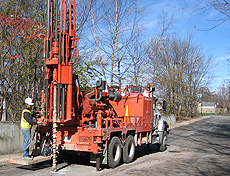Drillers will sample soil, rock at proposed neutrino site
 |
| A crew will use a drilling rig similar to the one above to collect soil and rock samples on Fermilab's site. Image courtesy of the Groff Testing Corporation. |
The preliminary design for a proposed long-baseline neutrino project at Fermilab is about to take a step forward.
Starting next week, engineers will begin to collect the geological information on Fermilab's site that will guide the proposed project's design and the construction of underground tunnels and caverns.
"We need to understand the geological specifics for the potential project," said Fermilab engineer Tim Wyman. "The site investigation will give us an idea of the types and conditions of soil and rock we have and how the water flows in those areas."
To collect soil and rock samples, engineers will drill at three areas.
On Monday, Dec. 14, a crew will conduct seismic tests near the Main Injector to identify the soil and rock content. On Wednesday, Dec. 16, a crew will drill to depths of 100 and 240 feet at two locations near the Main Injector. The drilling and seismic tests will not affect the operation of the Tevatron or any other laboratory activities.
The most visible drilling will take place on Jan. 4 near Kirk and Giese roads on the west side of the laboratory. At this location engineers will collect soil samples down to 65 feet and rock samples down to 650 feet.
All drilling will take place during regular business hours and should last one to two days at each location. Fermilab does not anticipate any noise louder than that heard from regular traffic on Kirk Road. A crew will use a drilling rig to bore a three-inch diameter hole to collect the soil and rock samples. After the drilling is complete, workers will refill the holes to return the sites to their natural appearance.
Using funds from the American Recovery and Reinvestment Act, Fermilab awarded the $195,000 site investigation contract to the Groff Testing Corp., an engineering consultant firm in Kankakee. The firm will submit a report with its site investigation findings to Fermilab in early 2010.
The proposed long-baseline neutrino project, which could begin construction as early as five years from now, could potentially involve major construction on Fermilab's site. The laboratory will involve its Community Advisory Board throughout the design process.
— Elizabeth Clements
|